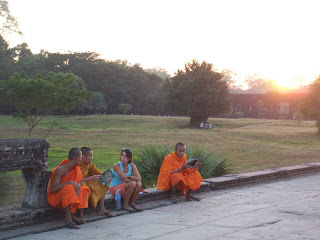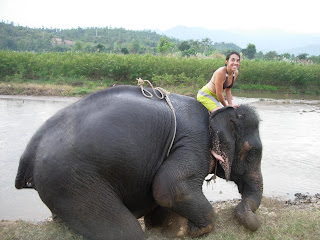Our travel into Cambodia began at 7am on November 30th when we joined 10 other tourists in a luxury mini-van to drive 5 hours to the Thai/Cambodia border. We fully anticipated mad chaos there, finding our transport to Siem Reap 150km away, and were delighted to find it rather seamless instead. A trustworthy Toyota Camry (the omnipresent taxi car) chauffeured us the 150 km, 4 hours, over the bumpiest dustiest roads you could imagine for the large sum of $10 a person. Funny since $10 hardly gets you a mile in a NYC cab. Also, interestingly enough, we were using our currency again. We found ourselves converting the $ to Thai Baht and back to the US $ because we have become so used to establishing cost based on the local currency!
Outside Siem Reap, the massive temple ruins built by the Khmer empire in the late 800s-1200s have made the city in Cambodia this decade’s tourist mecca. It has an almost Disneyesque feel given the abundance of luxury hotels and restaurants lining the streets. These temples are collectively referred to as Angkor Wat, though that is actually just one of the sights, albeit an expansive & intricate one. We spent three days visiting the ruins and found ourselves more impressed with each day. Clustered across miles of jungle and farmland, each temple is impressive in its own right, yet collectively provide an unparalleled glimpse of a foreign world and culture. It is impossible for our photos to capture the detail of the iconic stone face carvings in the Bayon temple, or the vast ornamental entry into Angkor wat, the jungle and tree roots overtaking Ta Prohm, or the intricate bas-reliefs depicting religious stories within Angkor Wat. That is why Angkor Wat has become a tourist enclave; you must see it, in its entirety, in person.
We timed our visit around the annual half marathon and 10k race which took place Sunday, December 2nd on a loop road connecting the temples/ruins of Angkor Wat. The proceeds went to land mine victims and also celebrated those handicapped athletes. It was a unique, multi cultural way to experience sunrise at the temples and be reminded of Cambodia’s painful history.
From the early 1970’s – late 1990’s Cambodia was essentially at war with itself. The most harrowing period during “The Killing Fields” of the Pol Pot years which then led to decades of a displaced population plagued by power vacuums, guerrilla insurgencies and 4 million+ mines strewn across the countryside. A quarter to a third of the estimated 8 million population of 1974 was killed in these years. It is not possible to visit Cambodia and have some sense of this recent history. We both read a powerful and haunting memoir, “Survival of the Killing Fields” which really illuminated the suffering experienced by these people. Our visit would not have been the same having not read this book and our newly acquired empathy for the country.
The people of Cambodia left an indelible impression on both of us. Musicians with missing limbs formed small bands and provided performances outside temples & town restaurants. A man with two stubs for arms sold books from a box hanging from his neck,with a sign that explained he didn’t want pity, or handouts, simply to be treated like a working man. We used the same tuk tuk driver for our 5 days in Siem Riep: Visna. Highly motivated, he has taught himself conversational level english through speaking with tourists. He lost both his parents and 2 of his 3 siblings during the senseless Pol Pot years. After spending the next 15 year fighting against the Khmer Rouge (fighting ended in 1998) he has done odd jobs until two years ago when he moved to Siem Riep to take advantage of the tourist influx. He brought us to his home, where he lives with his pregnant wife and two daughters. The one room home was the size of a master bedroom in the States. Stories like this are the norm.


 Thai-Cambodia border crossing in Poipet
Thai-Cambodia border crossing in Poipet The dusty, bumpy 150km"highway" from border to Siem Reap. There are rumors that an unnamed airline is paying off the Cambodian government to NOT repave the road; Interesting since there is only one direct flight from Bangkok to Siem Reap...
The dusty, bumpy 150km"highway" from border to Siem Reap. There are rumors that an unnamed airline is paying off the Cambodian government to NOT repave the road; Interesting since there is only one direct flight from Bangkok to Siem Reap...
 Family motoring on farm vehicle by a scooter gas station.
Family motoring on farm vehicle by a scooter gas station.
 The intricate Bas-reliefs that line 800 meters of corridors within Ankor Wat, illustrating mythical events.
The intricate Bas-reliefs that line 800 meters of corridors within Ankor Wat, illustrating mythical events.
 During one pre-sunset walk in Angkor Wat we befriended several monks and later visited one of their Wats.
During one pre-sunset walk in Angkor Wat we befriended several monks and later visited one of their Wats.
 Sunrise at Angkor Wat
Sunrise at Angkor Wat

















 Thai-Cambodia border crossing in Poipet
Thai-Cambodia border crossing in Poipet










































